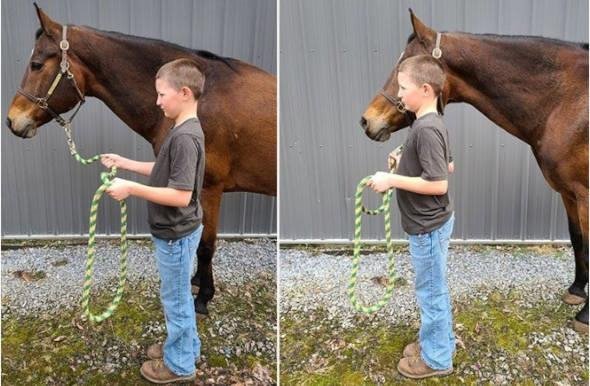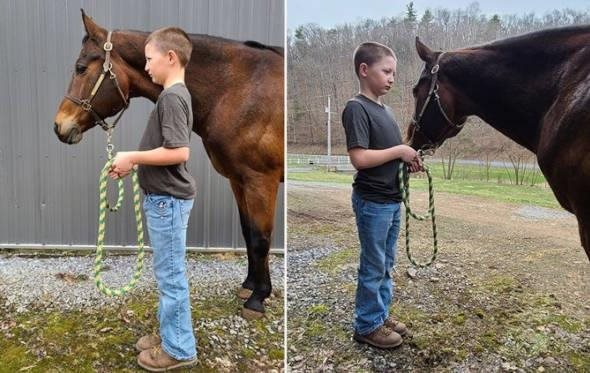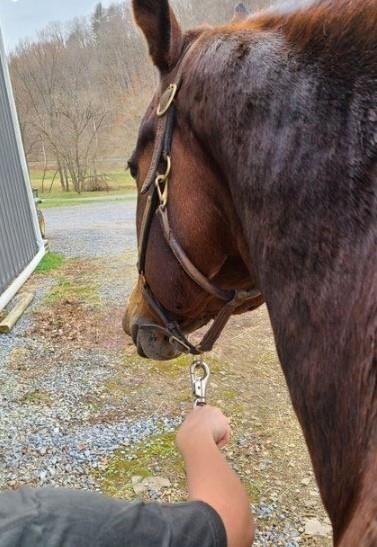By Bethany Bickel
Horses are sensitive, curious animals that respond to their surroundings. Safety is key!
Understanding Your Horse
As prey animals, horses often respond rapidly to disruptions in their surroundings. Horses are sensitive to movements, smell, touch, sounds, and sights. They have survived because of their ability to quickly recognize and respond to danger. This ability generates both advantages and disadvantages when handling. Horses respond to what they recognize as dangerous objects or situations by fleeing, fighting the threat, and/or bunching together. This is called the “flight or fight" response. The horse's most common reaction is to startle and flee, often called “spooking." To safely work with and handle your horse, you need to understand these key points of their behavior.
Haltering
Make sure the halter and lead rope are in good condition and fit properly: not too tight or too loose. The nose piece of the halter should lay across the bridge of the nose and roughly two fingers width below the cheekbone, and it should not be tight around the nose. Move slowly and be confident when approaching the horse. Stand to the left side between your horse’s head and shoulder. Reassure them by talking to them as your put the halter on. Slide the halter over the horse’s muzzle, or nose. If the halter fastens with a crown piece, place it behind the right ear and slide across behind the left ear, and buckle. Do not flop this piece over the horse’s neck as it may spook the horse or hit its eye and cause damage. Adjust if needed. If the halter fastens from the throat latch slide the crown piece over both ears and then fasten. Putting on a rope halter is very similar to flat halters (i.e.. Nylon halters, web halters), the main difference is that you tie a rope halter to fasten it instead of buckling. Bring the crown piece of the rope halter under and through the loop in the cheek piece. Pass the crown piece to the right and under the eye, to make the tail point to the left. Pull it back to the right, going through the loop you made to tie the knot. Pull snug. When finished the tail end should point away from your horse's eye, meaning to the right.
Where to Stand
As the handler you must control your horse's movement and create a safe environment for you, the horse, and people nearby. Never stand directly in front of your horse when leading or backing. Horses cannot see directly in front of them or behind them. Stand to the “near side" (left side) of the horse, between the head and shoulder, ideally at the throat latch. Standing behind a horse is also unsafe, as they have a blind spot there as well. When standing close to the horse, standing next to the horse's body is the safest. When standing still with the horse, point your feet toward the horse’s neck or shoulder. This allows the handler to maintain eye contact. Facing away from the horse is unsafe. The horse may react to movement before you are aware. Standing close allows you to act immediately if you feel your horse become tense or frightened.

Incorrect Positions. Photos by Bethany Bickel, Penn State

Correct Position. Photos by Bethany Bickel, Penn State
Leading

When leading your horse always use a lead rope, do not hold onto the halter, and never wrap the lead rope around your hand. Wrapping the excess rope around your hand can be dangerous if the horse shys away from you. Your right hand holds the rope under the horse’s head, and the other hand will hold the remaining rope. Be sure the excess lead doesn’t drag on the ground where it may become entangled in your legs or the horse’s legs. Hold the lead about six inches from the halter. When leading, extend your right elbow toward the horse and keep your knuckles on top of the lead. Horses should not pull or push you when leading but walk quietly and obediently beside you. If the horse moves too close to you, it should hit your elbow first and then move away from you. Look where you are going and face forward. When leading, apply pressure with the hand closest to the halter in the direction you would like the horse to move. Over time and with training, horses will respond to the handler's body and hand position, more so than pressure applied to the lead. Never pull the horse towards you to turn, always turn the horse away. Follow the horse, moving with them as they turn to prevent the horse from stepping on you. If you encounter problems with your horse it is recommended to seek help from an experienced equine professional.
Approaching
Move confidently and slowly when approaching a horse; walk, never run. Approach the horse from the front, toward their shoulder. Speak to the horse when approaching and extend your hand. Never approach a horse from the rear. If the horse begins to move away, stop, wait until the horse stops, then attempt to approach again. Make sure the horse always knows where you are. You can do this by talking to them (horses prefer low pitch sounds). Suddenly patting the horse on their body can scare them or make them move away rather than calm them, so pet them gently instead. If you are approaching the horse to catch them, once you get to their neck calmly but swiftly put the lead rope around the neck to have control of them for haltering.
You should always pay attention to the head, ears, neck, and body position because these are good indicators of what your horse is thinking and feeling. If you see a horse pin back its ears (lay them back against its neck), tighten or arch its neck, bob its head, or tuck its hind end under these may be signs that the horse may act aggressively. Be careful when approaching and ask experienced horse handlers for help. When working with horses in pastures remember horses are social animals that live in groups. If horses perceive danger their response will be flight, if that is not an option, they will defend the herd. If one horse runs, the whole group may take off so be prepared. Herds also have natural pecking orders or herd hierarchy. So, some horses may “push others around" a bit. As the person entering the pasture, make sure that you are confident and that the horses recognize you are there.
Releasing
When releasing a horse in the field, it is best to turn it around so it is facing the gate before removing the halter. Horses sometimes bolt sideways, or rear and spin when the halter is unfastened if they are anxious to join their herd or just have a lot of pent-up energy. This habit is unsafe because the handler can be kicked or run over. If the horse is very tense or excited before releasing it, point the horse toward a fence or wall if available. This lessens the horse's impulse to run off. Make the horse stand patiently, and once it relaxes, remove the halter. This may also happen when releasing multiple horses at the same time; in this case, make sure all handlers are prepared to release their horses at the same time. Trying to hold one horse back while its buddies gallop off is not a good idea unless you are very experienced. Horses may turn quickly and kick out toward the handler, so be aware. Move away calmly without turning away from the horse.
Helpful Hints to Remember:
- Do not stand directly behind the horse.
- Never wrap the lead around your hand or body.
- Teach your horse to be patient when being turned loose.
- Do not allow the lead to drag on the ground.
- Never stand, lead, or back standing directly in front of the horse.
- To discourage bolting, never open the gate and let the horse run through.
Remember, horses respond to their surroundings. Basic safety practices are essential in providing a safe and enjoyable experience for both you and your horse. Safe ground handling is important no matter what breed, type, or age of horse you work with.
Source : psu.edu